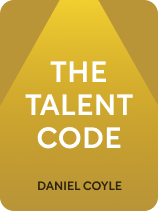

This article is an excerpt from the Shortform book guide to "The Talent Code" by Daniel Coyle. Shortform has the world's best summaries and analyses of books you should be reading.
Like this article? Sign up for a free trial here.
Where does talent come from? Are we born with talent?
In The Talent Code, Daniel Coyle goes beyond the nature versus nurture debate and digs into the science of skill-building to answer the question. Coyle says that while we’re not born with talent, there is a science behind developing it.
Keep reading to learn where talent comes from.
How Myelin Relates to Talent
Where does talent come from? Coyle says it actually stems from myelin. All of our thoughts and actions are the result of electrical signals being transmitted across networks of neurons (or nerve cells) in the brain. Within this system, myelin—a layer of fat and protein—forms a sheath around the axon (stem) of each neuron. This myelin sheath acts as insulation that prevents electrical signals from leaking out of the pathways between neurons—thereby increasing the signals’ speed and strength. A highly-myelinated neural pathway is able to execute commands from your brain (for example, a command to pitch a fastball) more efficiently than pathways with less myelin.
When you repeatedly activate a neural pathway by performing a particular action over and over again, you send a signal to your brain that that pathway is important. It responds by increasing the amount of myelin encasing it. In other words, the more time you put into practicing an action, the more myelin you’ll build around the corresponding neural pathway.
(Shortform note: Coyle explains myelin’s role as an insulator that prevents leakage of the electricity traveling across important neural pathways. However, he doesn’t go into detail on the other essential role that myelin plays: making the signals move faster. An axon with a myelin sheath around it has gaps in the sheath called Nodes of Ranvier; as electrical signals jump across these gaps, they recharge. In other words, the presence of myelin creates a structure that “signal boosts” electrical signals as they move, decreasing the time it takes them to travel from the beginning to the end of a circuit.)
What Is Meaningful Practice?
Meaningful practice, according to Coyle, is an intensely focused, targeted repetition of skills at the edge of your ability. It’s incredibly helpful for building talent. It should be doable, but push you just beyond the limits of your current skill set. In other words, you aren’t simply repeating an action you already know how to do well—you should be struggling to perform the action. This “development zone,” the state of struggle between an action you know well and what you want to achieve, takes concentrated effort and focus. You’re working on a skill that’s new to you and therefore doesn’t come naturally.
Crucially, Coyle notes, in the development zone, you will repeatedly make mistakes and correct them. This is essential because you build more myelin when you make mistakes. He explains that struggling and making mistakes when attempting a certain action signals to your brain that your current neural connections controlling the action are suboptimal. It responds by reinforcing these connections through myelination.
(Shortform note: Coyle’s discussion of the “development zone” aligns with the educational psychology concept of the “Zone of Proximal Development” (ZPD). The ZPD—the gap between what a student can and can’t do on their own—is the key focal point for achieving a task’s next level of mastery. Lev Vygotsky, the psychologist who developed this concept, emphasized that a student needs three components to learn: supportive activities that carry the student to the next level; social interaction, including dialogue and collaboration; and a knowledgeable coach or teacher. As we’ll see through the rest of this guide, these criteria align closely with Coyle’s elements of meaningful practice, impassioned motivation, and coaching.)
You might think of meaningful practice as mental weightlifting: You have to lift increasingly heavy weights to build up your muscle. If you were to repeatedly lift small, easy weights, your muscles wouldn’t grow and you wouldn’t become stronger. In the same way, you must practice increasingly challenging skills to build your myelin. If you practice an easy action repeatedly, your myelin won’t grow and your skills will plateau.
Impassioned Motivation Has the Power to Create Talent Epicenters
According to Coyle, impassioned motivation doesn’t just drive individuals toward the commitment necessary to developing exceptional talent. Applied to a group—such as a school, town, or family—impassioned motivation can create an epicenter where numerous people develop extraordinary talent.
Coyle notes two sources of impassioned motivation in groups: a breakthrough talent and competition and collaboration.
Breakthrough Talent
Seeing others achieve greatness can be highly motivating. This doesn’t just work on the individual level, though—this is often a driver of “talent epicenters.”
When one person in a community develops extraordinary talent and gains fame, she sends a key environmental signal to her community: Someone “like them” or from their background can succeed. This sparks impassioned motivation within the community—members showing a desire to join her ranks and a belief that they can.
Coyle explains that this is why, in his research, he often found cases of one breakthrough talent finding recognition—and then seven to 10 years later, many others from the same community following suit.
(Shortform note: According to research, exceptional success within your community can be motivating because it piques interest and curiosity. First, because the success is “close to home,” it’s more interesting than a success that’s not related to you in any way. Second, seeing someone from your background succeed prompts you to ask questions to understand how they did that—setting you up to follow similar steps.)
Collaboration and Competition
Coyle notes that another contributor to talent epicenters is continuously-present challenge. Often, groups of exceptionally talented individuals are found in environments where they are constantly exposed to each other’s talent, so they both collaborate and compete with one another.
In this type of environment, group members are driven to prove their belonging among the high-achievers, repeatedly rising to the challenge of meeting the talent and ability of their competitors. In other words, their environment creates consistent, challenging repetition at the edge of their ability
(Shortform note: This upward spiral of competency, where each opponent provokes the other to learn and grow, demonstrates a virtuous cycle: a feedback loop where each element positively benefits the others. So while having a ferocious rival may feel like an obstacle to your success on the surface, they’re in fact a huge part of what drives your growth. The heights of any discipline grow through competition; without that back-and-forth, the skill would stagnate.)

———End of Preview———
Like what you just read? Read the rest of the world's best book summary and analysis of Daniel Coyle's "The Talent Code" at Shortform.
Here's what you'll find in our full The Talent Code summary:
- A deep dive into where great talent comes from
- The key elements of the type of practice you need to develop talent
- Why it's never too late for greatness, if you know how to grow it






